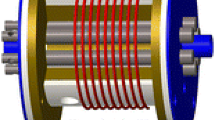Abstract
The application of an ion-guiding buffer gas-filled hexapole collision and reaction cell in ICP-MS has been studied in order to give a preliminary performance characterization of a new instrument providing this feature for increasing the ion yield and decreasing contributions from Ar induced interfering molecular ions. As buffer gas He was used while H2 served as reaction gas. Addition of the latter can be an effective means for reduction of typical argon induced polyatomic ions (Ar+, ArO+, Ar2 +) by orders of magnitude owing to gas phase reactions. Molecular interferences generated in the cell can be suppressed by a retarding electric field established by a dc hexapole bias potential of –2 V.
Similar content being viewed by others
Author information
Authors and Affiliations
Additional information
Received: 10 May 1999 / Revised: 4 June 1999 / Accepted: 12 June 1999
Rights and permissions
About this article
Cite this article
Feldmann, I., Jakubowski, N. & Stuewer, D. Application of a hexapole collision and reaction cell in ICP-MS Part I: Instrumental aspects and operational optimization. Fresenius J Anal Chem 365, 415–421 (1999). https://doi.org/10.1007/s002160051633
Issue Date:
DOI: https://doi.org/10.1007/s002160051633




